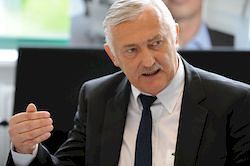
Hearing aid instead of hearing loss
“There is no hearing pill! There is an extremely high state of the art in hearing aids,” says Prof. Dr. Viktor Bonkowsky, Head Physician of the Department of Otorhinolaryngology at Nuremberg Hospital.
And he presents figures that are startling: Of those aged 61 to 70, just 21 percent still have normal hearing, and among those over 80, just one in fifty can still hear normally.
A hearing aid can help with gradual hearing loss
At first the rustling of leaves during a walk becomes quieter and quieter, the turning of the page of the newspaper is no longer audible. Everyday sounds that slowly disappear, but whose disappearance is hardly noticed.
“The most common term in life at some point becomes ‘how please’ because you don’t understand something. Or, in the worst case scenario, they make up an answer that doesn’t fit the question.” says one affected person. This is the everyday life of many people whose hearing ability slowly declines and hearing loss sets in.
Dramatic numbers
For many sufferers, going to the acoustician is associated with the stigma of aging. But Bonkowsky believes that this is no longer the case: “I recently advised a patient to remove his glittering ear piercing before undergoing anesthesia. But on closer inspection, this turned out to be an ornate hearing aid,” reports the Nuremberg professor.

Prof. DR. Bonkowsky explains
He points out that it takes an average of eight to nine years before slowly progressive hearing loss causes such severe disruption to everyday life that people seek help from a doctor or acoustician.
And during this time, the affected person not only misses a lot of audible details, but his or her brain also forgets how to interpret and classify the sense of hearing.
This is precisely why the early visit to the acoustician or ENT physician is so important. Bonkowsky says: “The hearing aid must be prescribed in time and then worn consistently. This improves hearing comprehension enormously.”
High-tech behind the ear – the hearing aid
Christian Honsig Managing Director of Sivantos GmbH, the manufacturer of Siemens hearing aids, recognizes a trend to go to the doctor or acoustician earlier and earlier: “The target group is getting younger and we see clear tendencies that the age is going down further. These are people who are active in their professional lives. This also changes the requirements.”
Connectivity and networking are topics that interested a younger target group. Siemens hearing aids already beat many technical devices in terms of energy efficiency: many millions of transistors in a current-generation hearing aid do their job in a very small space – powered by a small battery that has to last several days.
“About 1.000 data records are exchanged per second between a hearing aid in the left ear and a second one in the right ear.”This is how spatial hearing is created, which is so crucial for understanding speech in crowded places like churches or beer tents.
And best of all, the hearing aid automatically recognizes where it is being used: “An important issue in development is that the hearing situation is automatically recognized and the device adjusts itself correctly without the wearer having to do anything,” says Sivantos CEO Honsig.





